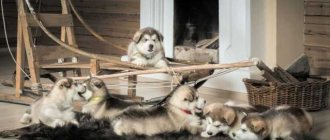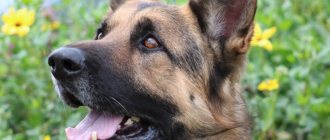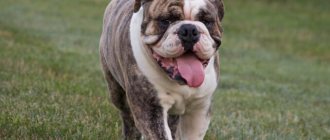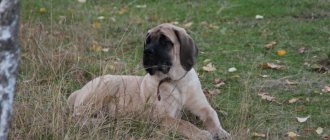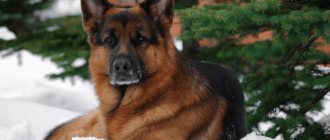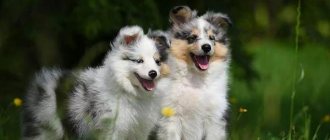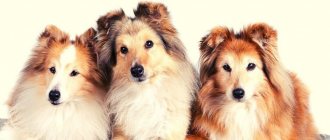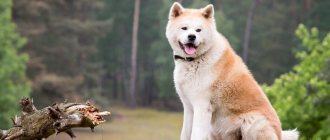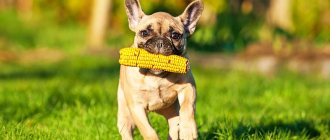| Breed name: | Alaskan Malamute |
| Breed name in English: | Alaskan malamute |
| Country of origin: | Alaska (USA) |
| Type: | Large dog |
| Weight: | 35-56 kilograms |
| Height (height at withers): | 58-71 centimeters |
| Color | White, black, blue, grey, agouti and combinations |
| Wool length | Average |
| Lifespan: | 10-12 years |
| Character | Active, playful, loyal |
| Number of puppies (average): | 5-8 |
| Price of puppies: | 600-2000$ |
Appearance
— Advertising —
The size of an adult dog can vary, but, on average, the height at the withers of males is 64-71 centimeters, females - 58-66 centimeters.
Average weight: 35-56 kilograms.
The description of the Alaskan Malamute should begin with the fact that it is quite a powerful animal. Dogs have large, wide heads and a large muzzle, which is equal to the width of their skulls. They have medium-sized almond-shaped brown eyes. The breed standards state that individuals with lighter coloration have lighter eyes.
— Advertising —
Pets' ears are small and triangular in shape, with slightly rounded tips. They are widely spaced on the pet's head. Malamutes have a huge upper jaw and a strong lower jaw with a scissor bite.
The dogs' body is powerful, muscular, and their back is straight. The dogs' fore and hind limbs are well developed and very strong. The animals' tails are covered with thick hair, set high and slightly curved upward. When at rest, these dogs hold their tails down. Dogs lift their tail up when they are petted or excited.
The Malamute has a thick coat, but it is soft to the touch. They have a dense, oily undercoat, 2.5 to 5 centimeters thick. It provides protection for animals from external threats. The coat and undercoat can vary in length and density. For example, the thickness around the shoulders and neck is greater.
This dog boasts a variety of colors. Color varies among the following shades:
- Agouti and white.
- Black and white.
- Blue and white.
- Gray and white.
- Sable and white.
- Silver and white.
- White.
- Red and white.
The breed always has white on the lower parts of the body, on various parts of the legs and on the face. This coloring on the face looks like a mask or a cap. Dogs may also have a white spot on their forehead and a white stripe in the form of a collar. The most characteristic color of the Alaskan Malamute is black body color. It helps the dog avoid ultraviolet exposure to the sun in the north.
The following lines of Alaskan Malamutes are distinguished:
- Kotzebue Line. The dogs are relatively short in stature and gray in color. It is believed to be a cross between a husky, a husky and an Alaskan malamute.
- Line M´Lut. This line is distinguished by its taller growth and different colors.
Regional varieties of the breed are also distinguished. For example, Siberian, Japanese, Canadian, Chinese and others. Photos are presented below.
Malamute and Husky - what is the difference, the main differences
Alaskan Malamutes and Huskies are close relatives, so they are very similar, and many experts argue that these breeds have common roots - both breeds were descended from wolves.
The main differences between representatives of these breeds include:
- eye color - in Huskies they can be either brown or blue, but for Malamutes blue eye color is a defect;
- Huskies can run short and long distances very well, but Malamutes are slower;
- Husky's body weight and height are significantly less;
- Malamutes' fur is coarser and tougher, there cannot be any inclusions in color;
- Husky has a more elongated muzzle shape;
- The Malamute's tail is a fluttering fan, while the Husky's has a fox-like tail;
- Malamutes' ears are more widely spaced than those of their relatives.
Pros and cons of a dog
Pros:
- They are funny and cheerful.
- The dogs are very smart and learn quickly.
- Pets are good for children of all ages.
- Animals have a good sense of humor, although sometimes they are mischievous.
- This breed is an ideal choice for people who lead an active outdoor life and love dog sports.
Minuses:
- Dogs shed a lot, especially in spring and autumn.
- Animals can be very stubborn.
- A special feature is that pets love to dig large holes.
- They are not the best choice for first-time dog owners.
- Malamute puppies are expensive. Their maintenance will also cost you a lot.
- Dogs need constant exercise, both physically and mentally.
- They need a lot of care and attention. The dog suffers from separation anxiety if left alone for a long time.
Read reviews about a pet online before bringing it into your home.
Owner reviews
According to reviews from the owners, if you work with a puppy of this breed constantly from the very beginning, then in the future such a dog will be a faithful, obedient friend who recognizes the leadership of its owner and shows practically no stubbornness.
However, if there are kids in the house, then it is better to hold off on purchasing a Malamute and wait until the children are older.
History of the breed
Like most Spitz dogs, the Alaskan Malamute evolved in arctic regions. The origin of the breed is not known with certainty. They lived near Norton Sound on the northwest coast of Alaska. The word "Mahlemut" comes from "Mahle" - the name of the Inuit tribe, and "mut" means village. These animals were used by the native people of northwestern Alaska to haul heavy sleds to hunt seals and polar bears. The dogs also served as bait.
With the discovery of gold in 1896, foreigners began to come to Alaska. To amuse themselves, they organized races among their dogs. They also crossed breeds of local dogs in the hope of breeding the fastest individual. The pure Malamute was in danger of extinction.
However, in the 1920s, a greyhound racing enthusiast from England obtained several purebred dogs. After this, he began breeding traditional Malamutes. The breed's reputation grew. Some of the individuals were chosen to assist Admiral Byrd on his 1933 expedition to the South Pole. During World War II, dogs were used to transport goods and animals.
In 1935, the breed received recognition from the American Kennel Club.
Maintenance and care
To keep your pet healthy, you need to remember a few rules: carefully monitor its diet, exercise, and regularly brush its teeth and coat. Also, be sure to stick to your veterinarian's schedule for vaccinations and checkups.
- Walk your dog for at least an hour a day. Daily activity helps dogs avoid boredom, which leads to destructive behavior. Going outside will eliminate most of your pet's instinctual urges: chewing, digging, chasing.
- Make sure everyone in your family spends plenty of time with your pet.
- Feed the animals food that contains a mixture of different amino acids. Dogs may suffer from zinc deficiency. Sometimes animals need more of an element than a balanced dog food contains.
- Alaskan Malamutes were bred to be working dogs in cold environments. As a result, they have thick coats that require intensive grooming. Brush your dog thoroughly at least twice a week. Occasionally trim the long fur around your pet's feet and nails.
- Bathing the animal is optional. This may be necessary if the fur gets stuck together. When bathing, use dog shampoo and warm water. Don't let your pet go outside in cold weather until his fur is completely dry.
- Your pet needs a warm, calm place to rest. The dog doesn't like drafts. You might consider buying a pet bed or making one out of a wooden box. Lay down a blanket or pillow for softness.
Types of colors
The options for Malamute coat colors are amazing in their diversity. Basically, this is a combination of white and other shades, making each individual individual.
The monochromatic coat color of representatives of this breed can only be white .
Black and white
The awn is black, the undercoat is black or dark gray. The Seal and White color can also be included in this category - in such dogs the guard hairs are completely black or only at the tips, and the undercoat is white or cream-colored.
Puppies of these colors have almost the same color at birth; it is almost impossible to predict what the adult will be like.
Gray with white
The guard hairs are gray, and the undercoat is white, cream or light gray. Any inclusions of a reddish tint are unacceptable.
Although there may be darker or black hairs along the topline, Malamutes with this coloration give the impression of a gray dog.
Sable with white
The awn is black or gray, the undercoat has a reddish tint. Visually, shades of both black and red are clearly visible.
Silver with white
In such dogs, the guard hair is pigmented with a light gray color, and the undercoat is white.
Gray-white, silver-white and sable-white colors can be classified as one color group, which most people mistakenly consider to be the only correct one for this breed.
Red with white
The awn is colored in any shade of red: from rich brown to golden yellow. Black color is not acceptable.
Blue and white
Blue color is formed as a result of genetic dilution of black. Blue and white Malamutes have blue rings on the guard hairs, and the undercoat is dark gray or blue.
Solid white
These Malamutes have a snow-white coat and the same undercoat. Some individuals have a less pronounced creamy mask. They can only be born as a result of the mating of two white individuals.
Nutrition
Alaskan Malamutes are large dogs, so feeding their pets will not be cheap. Dogs love to eat, but are not picky eaters. Therefore, they will eat everything you offer them. Give your pets high-quality food. Bad food can lead to the development of deficiencies of minerals, vitamins and other valuable substances. Feed them once or twice a day.
An adult Malamute should eat the following amounts of food per day depending on the animal's activity:
- With a weight of 38 kg – 366-482 g.
- With a weight of 40 kg – 381-501 g.
- With a weight of 45 kg – 409-538 g.
- With a weight of 50 kg – 437-575 g.
- With a weight of 56 kg – 465-612 g.
Application
The Alaskan Malamute is a sled dog designed for transporting goods. Puppies begin to be trained as soon as their joints and muscles are formed. Therefore, it is important to know to what age animals grow. They reach the size of adults by 7-8 months. However, it is better to wait up to a year for the bones to finally become stronger.
You can raise a puppy as a hunting assistant. He will work for the beast in deep snow. But he will turn out to be a useless guard. An animal can scare an uninvited guest with only one thing – its large size.
In Russia, Alaskan Malamutes are practically not used for their intended purpose. They are often found by fans of extreme recreation, hiking and cross-country skiing. The pet will be an excellent companion for a person involved in sports.
Breeding
In female Malamutes, the first heat occurs at 8-12 months. Then it is repeated every six months. Its duration ranges from 18 to 20 days. At this time, the animal may become disobedient, excitable, and refuse food.
Before breeding dogs, you need to pay attention to the following. Decide what color you want offspring, based on this and select a pair. To avoid incest, analyze the previous 3 generations by pedigree.
Pregnancy of bitches lasts 59-63 days. About 9-10 hours before giving birth, your dog will begin to behave restlessly, this is due to the start of pushing. As a result of childbirth, 5-8 babies appear.
To what age do they grow?
Like other large breeds of dogs, Malamutes grow in height until about 1.5 years, later they gain muscle mass and weight for several more months.
Moreover, the most intensive growth occurs in the first six months of a puppy’s life.
NOTE!
The onset of heat in a female dog can significantly reduce the rate of growth and weight gain.
In general, it is believed that a malamute grows in width up to two years and after this age, the dog is considered to be fully grown.
Puppies
When purchasing a baby, you must understand how vulnerable he is in the first months of life. Here are some dangers a puppy may face at 6-8 weeks:
- Plants.
- Water.
- Electrical cords.
- Poisonous products and substances.
- Predator birds.
You should make sure to purchase the right toys for your baby. Why is it necessary? Otherwise, he will chew your things. Do not give him clothes or shoes as toys, as the puppy will use them regularly in the future. Make sure the toys have the appropriate texture and size.
Place an ID collar on your pet. If your pet gets lost, it will be returned to you immediately.
Many dog breeders don’t know what to feed their little friend. It is important for the baby to follow a diet. Otherwise, he may have an upset stomach. Breeders usually give new owners a feeding schedule for their puppies.
Approximate amount of food for babies, depending on body size:
- 2 months – 298-329 g.
- 3 months – 386-417 g.
- 4 months – 425-456 g.
- 5 months – 495-526 g.
- 6 months – 557-558 g.
- 7 months – 559-590 g.
- 8 months – 524-555 g.
- 9 months – 491-526 g.
- 10 months – 458-489 g.
- 11 months – 429-460 g.
- 12 months – 402-433 g.
- 13 months – 399-430 g.
- 14 months – 395-426 g.
Babies aged eight to twelve weeks need four meals a day. From 3 to 6 months of age, feed them 3 times a day. From 6 months to a year – 2 times a day. Photos of the puppies are presented below.
Dog character
Although these individuals look large and impressive, they are extremely friendly in nature. It is unlikely that your dog will make a good house guard, since he rarely howls or barks.
Pets must be well socialized from childhood. Introduce them to a wide range of people, animals and situations early in their lives. They are not the best choice for those who are looking to get a dog for the first time. The Malamute must know its place in the “pack” and who is boss in the house. Therefore, you must initially become a leader for your pet.
Malamutes are excellent diggers and will happily dig a hole to escape from the garden. For this reason, many owners do not leave them outside unattended.
Dogs have a high level of hunting instinct. They will chase any animals that come into their sight.
By nature they are playful individuals. Some of them excel in many dog sporting activities.
Dogs are loyal to their owners. They hate being left alone. Dogs prefer to always be close to their owner. They are suitable for families where at least one person remains at home. Long separation from the owners leads to excessive activity and aggression of the dog.
Education
Education, training and socialization of Alaskan Malamutes should begin as early as possible. They are smart and, with the right approach to training and education, learn new things well. However, dogs do not react too quickly to any commands. This must be taken into account when training them. Successful training requires time and patience. Pets will enjoy tasty rewards during exercise.
It is important for these dogs to know their place in the “pack” and who the “alpha dog” is. Otherwise, they take on this role themselves. Puppies need to be taught basic commands from childhood. For example, like this:
- Come.
- Sit.
- Stay.
- Quiet.
- Leave it.
- Place.
How much does an Alaskan Malamute cost?
The cost of a Malamute puppy with great exhibition prospects can reach 100 thousand rubles.
Children without documents are valued much cheaper, their price does not exceed 10-15 thousand rubles. Such a significant difference in price is explained by the fact that puppies - potential winners of exhibitions and competitions - are usually used for breeding, producing excellent offspring. But no one has such views on kids without a “passport”; they remain just pets. The cost of Alaskan Malamute puppies is also influenced by the regalia of the parents. The offspring of the titled winner of world exhibitions will cost the most. Puppies from a dog that won the Russian Championship are somewhat cheaper. Well, the lowest price will be for puppies whose parents only have an “excellent” rating.
Diseases
Fluffy Alaskan Malamutes suffer from certain inherited and acquired health problems. The most common are:
- Hip dysplasia.
- Visual impairment, including hereditary cataracts.
- Alaskan malamute polyneuropathy.
- Epilepsy.
- Gastric torsion/bloating.
- Chondrodysplasia (dwarfism).
- Alopecia X.
Dogs often suffer from a condition known as alopecia X. This is an inherited skin disorder. The condition goes by other names, including black skin disease or follicular dysplasia. The disease affects breeds with thick, dense double layers of coat.
This endocrine disorder may be due to dogs producing too much cortisol. Symptoms include the following:
- Excessive hair loss.
- The remaining hair appears brittle and dry, especially around the neck and tail.
- Bald patches appear on certain parts of the body, where the skin turns black.
Contact your veterinarian who can help you deal with this problem.
When a dog experiences seizures, the condition is referred to as having idiopathic epilepsy or generalized primary epilepsy. Research has shown that about 6% of dogs may suffer from this condition. This can be caused by heredity, as well as the following conditions:
- Brain tumors.
- Head injury.
- Low blood sugar or oxygen levels.
- Diseases or infections.
- An infectious or inflammatory disease of the nervous system.
- Toxins.
- Botulism.
- Parasites
- Low serum magnesium or calcium levels.
- Imbalance of sodium or potassium levels in the blood.
- Kidney failure.
- Hyperthermia.
- Deficiency of thyroid hormones.
Be sure to contact your veterinarian who can help you make the correct diagnosis.
Interesting Facts
- The Alaskan Malamute is a cargo dog. It is grown to transport heavy loads over long distances.
- The dog's power was used during the Klondike Gold Rush.
- Alaskan Malamutes do not have blue eyes. Their eyes range from light to dark brown and amber, depending on the color of their coat.
- These are the official state dogs of Alaska.
- Dogs were used in World War II to detect mines, carry weapons, and perform search and rescue duties.
- There is a giant malamute. The characteristic of the breed is that the weight of females and males is truly gigantic: 55-80 kilograms.
- Films in which you will see Malamutes: “White Captivity”, “Iron Will” and “The Last Trapper”.
